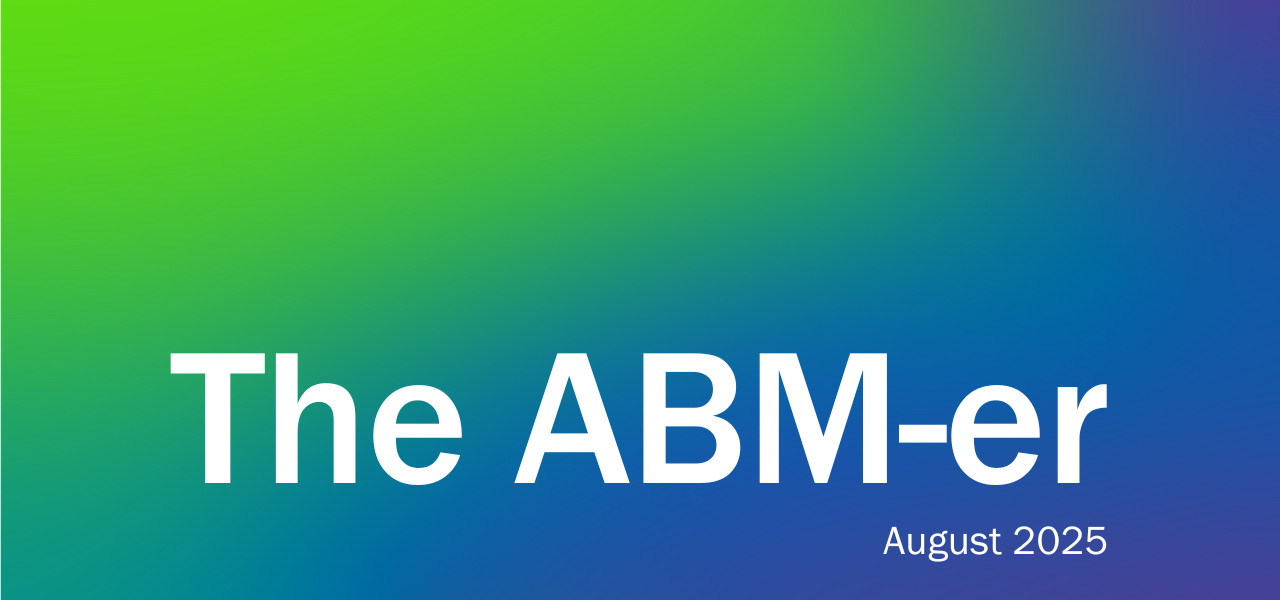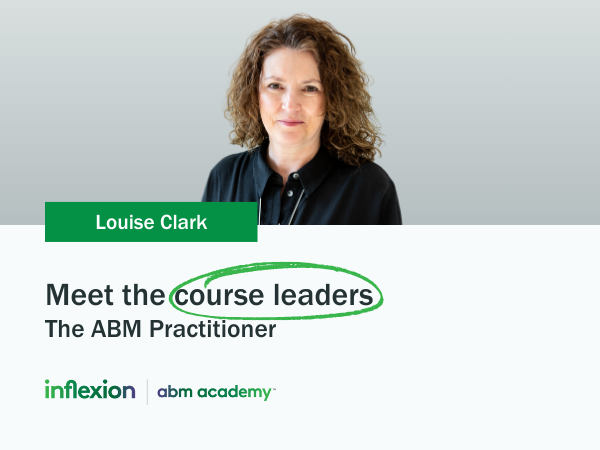Sharing research, insights, trends and advice to help you keep up with the latest in ABM
Hello everyone,
Welcome to The ABM-er. This month, I’m taking a deep dive into Strategic ABM, sharing some benchmark data from Inflexion Group and some insights from my book, Account-Based Marketing: The definitive handbook for B2B marketers.
In this edition, we’ll look at how companies approach Strategic ABM, hear about Samantha Bentley’s success with it at Kyndryl, and also get a perspective on how to make it work from Laura Towers Romano at Accenture.
You can find more insights to help you on Inflexion Group’s Resources page, here: http://bit.ly/46O5UNB
I hope you find this month’s edition valuable. Do let me know if you have any comments or questions!
And if you enjoy it, please subscribe to receive future editions.
Many thanks,
Bev.
How are companies using Strategic ABM?
Strategic ABM is where an ABM-er acts as the CMO of an account, working as part of the account team to build and execute a marketing plan just for that account. This type of ABM relies on a close working relationship with the account director and their team, and so a full time ABM-er typically manages 1–3 accounts, depending on their size and complexity.
In Inflexion Group’s 2024 ABM benchmarking study, we found that:
- 84% of companies were using Strategic ABM, and of those, the majority were applying it to the top tier of their existing customers.
- 83% of ABM-ers create custom content and thought leadership for this type of ABM, with 61% tailoring existing content.
- The five tactics that programme leaders say work best are high touch and resource intensive: VIP event experiences, executive engagement, innovation workshops, bespoke landing pages and bespoke videos.
- Average spend per account per year is $38k (with a range from $10k–$93k).
Samantha Bentley’s story from Kyndryl demonstrates the use of customised VIP experiences in Strategic ABM – and the results they can achieve.
ABM at Kyndryl brings a data breach to life
Here’s a summary of the case study provided by Samantha Bentley, Design Strategy at Kyndryl, for my book.
The challenge
When Kyndryl separated from IBM in 2021, the newly independent company faced significant perception challenges with existing clients. A major high-street retailer had ‘pigeonholed’ them based on their historical relationship, limiting engagement to the IT department with no access to C-suite conversations beyond the CIO.
Kyndryl’s objective was clear: redefine their brand positioning and unlock new growth opportunities by establishing themselves as a transformation partner and thought leader in cybersecurity and resilience. However, they needed to differentiate their approach and demonstrate expertise that extended far beyond their traditional infrastructure services. As the team explained, “We wanted to show, not just tell our story.”
The approach
Rather than relying on traditional presentations or proposals, Kyndryl developed an innovative solution: a bespoke, immersive, real-time data breach simulation designed specifically for 11 board-level executives at the retailer.
The team conducted extensive research into real-life reactions to data breaches, ensuring the scenarios would feel authentic and urgent. They then produced completely customised materials using the company’s actual name and branding, including mocked-up customer tweets expressing outrage, realistic news bulletins and video calls from concerned stakeholders, and partner emails and voicemails reflecting the escalating crisis.
To maximise impact, the simulation was hosted in the client’s own boardroom, creating an immediate sense of familiarity and realism. The team crafted an “escape-room” atmosphere with escalating urgency that mirrored the pressure executives would face during an actual cyber incident. Throughout the development process, they collaborated closely with the client’s IT department, positioning them as internal champions who understood the value of the exercise.
The results
The impact was immediate and substantial. Within the first month, the simulation generated £200k in new pipeline opportunities. The event achieved 100% attendance from the targeted senior business leaders – a remarkable feat given the seniority of the audience – and earned 100% satisfaction in the post-event survey.
The COO’s response captured the sentiment perfectly, declaring it “one of the best exercises they had ever done.” More importantly for Kyndryl’s strategic objectives, the simulation successfully established new relationships with senior executives outside the IT function, dramatically expanding their sphere of influence within the organisation.
The exercise significantly increased awareness of Kyndryl’s expertise in security and resilience, repositioning them from a traditional infrastructure provider to a strategic transformation partner. The team also created a reusable “event-in-a-box” simulation asset that could be adapted for other sectors, maximising the return on their investment.
Beyond the immediate commercial success, the initiative fundamentally improved the reputation and working relationship between the client and Kyndryl team, laying the foundation for deeper, more strategic partnerships in the future.
Another company that has been using ABM to build long term partnerships with its top clients for many years is Accenture. Laura Towers Romano, Director of Client Relationship Marketing shares her perspectives on how to approach Strategic ABM.
Perspectives from Laura Towers Romano at Accenture
What do you see as the key steps in the Strategic ABM process?
The key steps to Strategic ABM often include introductions and expectation setting with the account, synthesis of insights about the client and challenge to be solved for, a permeating commitment to maintain the data that supports the client experience followed by solidity of a well-devised strategy with strong marketing objectives in support of the account goals, clear success factors, and a smart approach to engage and shift perception with critical decision makers, key influencers and prospects.
The good news is that for so long, these first few steps required a heap of marketers’ time to synthesise qualitative and quantitative insights from numerous sources in support of their strategy development. Today, we can lean in with AI to accomplish the task faster. And with the AI gathering and assessing elements like the client’s context and industry landscape, it enables the marketer to redirect the time they’d have spent researching to higher value activities, like focusing on the client’s pain points, key audiences to engage to reach objectives, and the best way to segment those audiences to engage each contact with depth and frequency via the right channels, with the right messages and at the right times.
Doing so is about optimising what you have at your fingertips in terms of data, tools, technologies, partners and channels, both within your company and in the client’s organisation (a pro tip), to reach your targets in the best ways. And the magic comes in when you’re able to use the data and insights gathered as activation progresses and reinvest those insights into adapting next best actions with clients along the way.
Can you expand a bit on audience segmentation?
Audience segmentation always anchors back to strategic goals and objectives and the players behind reaching those strategic goals and objectives. What are we trying to achieve? Who are the prospects? Who are the clients? And who are the influencers behind them who too should be engaged to grow a preference for partnering with the organisation? Then it is important to consider the perception needing to be shaped with them, the goals of their function or leadership role, key messages that will address their pain points, the relationship stage (and sometimes even sales cycle stage) they’re in, cultural factors, channels, timing, etc.
And whilst it may be tempting to immediately build individualised engagement plans, growing group thinking and shared experiences can be quite a powerful play. You may use different marketing tactics, marketing channels, or even account teammates as channels to engage them. Segmenting audiences into groups can be a strong strategic benefit to reach more targets more often, delivering deeper engagement success with the objectives at hand.
How important is it to make sure the messages are aligned so that you show up with one voice?
Messaging is critical. You need a differentiated point of view with an account that brings the best of your organisation through to them in a way that feels relevant to their goals and aspirations. This brings consistency – and trust – to the relationship. It’s not just about delivering on any one isolated project or messaging in a single proposal, but about consistently showing up as their prime partner, helping them reach those goals and objectives that are key to their organisation. A tip: don’t be afraid to bring the client in to co-create this with you. When done well (and well-timed), this can be an incredible way to gain extended buy-in and joint ownership of the story you and your client can share in market together.




